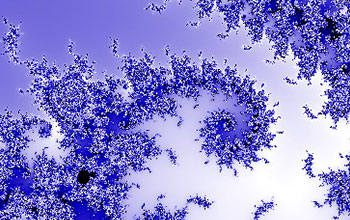Multimedia Gallery
"Blue Swirl" - Mandelbrot set
"Blue Swirl" fractal, part of the Mandelbrot set. [Exact location in M-set: centre-1.11131600e+0 + 2.24873215e-1i; max. iterations 12,000; view radius 5.082199e-4.] As the image is enlarged--the picture going deeper and deeper into the region near the boundary of the Mandelbrot set itself (black bits)--we see infinitely many fabulous patterns including miniature copies of the whole set, spidery filaments, pools and lagoons of color, devilish pitchforks and complicated spirals. This image was made using the KPT Fractal Explorer plug-in for Adobe Photoshop. The colors have been chosen to emphasize the structure and detail of the M-set, rather than to make an artistic statement.
More about fractals
Mathematician Benoit Mandelbrot introduced a set of equations in 1975 that impressed artists more than scientists. That's because his equations--called fractals--become amazing geometrical pictures. The Mandelbrot set is a fractal.
Fractals are self-similar structures, containing patterns within patterns. Fractal-like structures are found in nature in clouds, mountain ranges and coastlines. In fractals, the basic shape occurs infinitely many times in the set, an example of the self-similarity of fractals. If you were to magnify a fractal, it would reveal small-scale details similar to the large-scale characteristics. However, at magnified scales, the small-scale details would not be identical to the whole. In fact, the Mandelbrot set is infinitely complex, yet the process of generating it is based on an extremely simple equation involving complex numbers.
The Mandelbrot set is a mathematical set, a collection of numbers. These numbers are different than the real numbers that you use in everyday life. They are complex numbers, that is, they have a real part plus an imaginary part. The real part is an ordinary number, for example -2. The imaginary part is a real number times a special number called i, for example 3i. An example of a complex number would be -2°+°3i.
If you would like to read further about complex numbers and how they form the Mandelbrot set, see Introduction to the Mandelbrot Set: A Guide for People with Little Math Experience, by David Dewey. Portions of the text were reprinted here with permission from David Dewey. (Year of image: 1997)
SORRY: THIS IMAGE IS NOT AVAILABLE IN HIGH-RESOLUTION FORMAT
Credit: Courtesy Frances Griffin,
Images and other media in the National Science Foundation Multimedia Gallery are available for use in print and electronic material by NSF employees, members of the media, university staff, teachers and the general public. All media in the gallery are intended for personal, educational and nonprofit/non-commercial use only.
Images credited to the National Science Foundation, a federal agency, are in the public domain. The images were created by employees of the United States Government as part of their official duties or prepared by contractors as "works for hire" for NSF. You may freely use NSF-credited images and, at your discretion, credit NSF with a "Courtesy: National Science Foundation" notation.
Additional information about general usage can be found in Conditions.
Also Available:
Download the high-resolution TIFF version of the image. (360 KB)
Use your mouse to right-click (Mac users may need to Ctrl-click) the link above and choose the option that will save the file or target to your computer.

